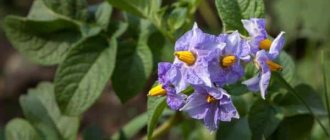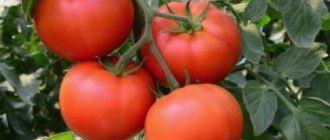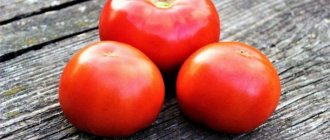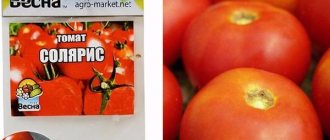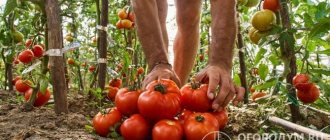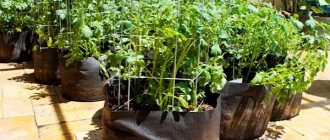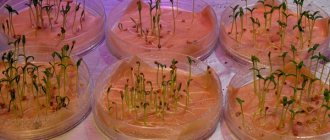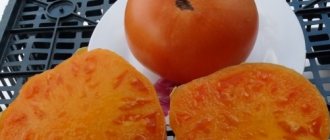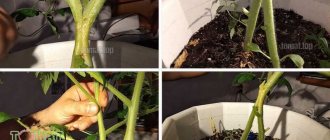Home/Cottage and vegetable garden/Growing tomatoes using Maslov’s most popular methods
Gardeners who grow tomatoes on their own plots are always trying to try new methods to get a good harvest. But one of the most effective growing methods was described back in the 80s of the last century by I.M. Maslov. It consists in stimulating root formation of plants.
The essence of growing tomatoes using the Maslov method
In 1985, the magazine Homestead Farming published an article: Roots are looking for soil. Its author, an amateur gardener from Kaliningrad near Moscow, I.M. Maslov described in detail his method of obtaining a large harvest of tomatoes by stimulating root formation.
A chicken is lame on one leg: what to do if chickens and chickens fall on their legs
Even in Siberian conditions, tomato bushes planted according to I.M. Maslov’s method give consistently high yields both in open ground and in greenhouses
It was based on the fact that under natural conditions a tomato bush spreads along the ground , so it is easier for it to develop roots and hold fruits that ripen in large quantities. And to save planting space, breeders strive to breed tall varieties with large fruits. As a result, the plant lives off a poorly developed shallow root, and the harvest breaks its branches.
Maslov’s rationalization proposal found a great response and is still being successfully used as effective.
The seedlings were planted in deep holes and watered only once, at planting. After which they just hilled up and covered with mulch. The plant, under the influence of aggressive wind and sun, spread along the ground and developed roots well in search of moisture. The harvest was always plentiful, the tomatoes were medium-sized, sweet and thick-skinned . Maslov proposed two new planting methods, in which the plant can grow its root system in proportion to the ripening of the fruit.
The first way to increase yield
Horizontal planting will seem easy even to a person with minimal experience in plant growing:
When growing tomatoes using the Maslov method, it is necessary to place the seedlings in the grooves so that the root system is directed to the south, and the tip of the bush is directed to the north.
- tomato seedlings are planted vertically in an unheated greenhouse to obtain an elongated, strong trunk;
- then it is transferred to open ground , where it is planted in a furrow lying down so that not only the root, but also the first pair of stems are covered with soil (the leaves must be removed from it);
- the location of the seedling should be strictly with its root to the south - this is done so that the plant can easily rise towards the sunlight;
- The more of the seedling is covered with soil, the more area there is for root formation.
This technique also solves the problem of thin, elongated seedlings that are difficult to plant vertically. Placed in this way, weak bushes will quickly gain strength and rise. You can plant two seedlings together at once.
Scheme of growing tomatoes according to the method of I.M. Maslova
By the way, Maslov drew attention to the fact that tomatoes love to be transplanted. He recommended that at the indoor growing stage, plant them twice, each time deepening them and increasing the distance between the seedlings to strengthen the root.
The second way to plant correctly
Refusal from pinching tomatoes in favor of root formation:
- the lower pair of stems should not be removed, but allowed to grow;
- when the main bush produces its first fruits, remove the leaves from the stepsons and bend them to the ground, secure them (you can simply pin them with a wire hook) and sprinkle earth on top;
- in order not to create strong shading in the center of the bush, the shoots must be bent as far as possible from the trunk;
- the stepsons will grow very quickly , the first fruits on them will appear a couple of weeks later than on the main trunk.
Scheme for growing tomatoes in 3 stems according to the method of I.M.
Maslova At the same time, they will not oppress each other - the tomato will remain a single plant with a common root system. The method is called growing in three stems .
Please note that these two techniques are not mutually exclusive. You can plant the bush horizontally, and later root the stepsons.
Advantages and disadvantages of the Maslov method
The obvious advantage of the method is the use of a small amount of planting material, from which a good harvest grows. This is especially valuable in situations where expensive varieties of tomatoes are purchased. However, it must be taken into account that planting with three stems is not the best option for growing low-growing tomato varieties. When planted this way, they may begin to rot. To avoid rot, fresh grass should be laid on the ground. When watering, you need to make sure that the soil is not constantly wet.
For tall tomatoes, the three-stem method is optimal. Such bushes will need to be tied in a special way. It is best to provide a separate loop for each bunch of tomatoes that will support it. You also need to be prepared that the crop grown using the Maslov method will ripen a couple of weeks later than usual. This occurs due to hilling, as a result of which the growth of the above-ground part of the plant is suspended for some time.
History of the Maslov method
Igor Mikhailovich Maslov first publicly announced himself in the 80s, when his article about tomatoes, “Roots are looking for soil,” appeared in the magazine “Homestead Farming.” Later a sequel, “Roots Found Soil,” was released. The gardener conducted an experiment on his plot and got a stunning result: Teplichny and De Barao tomatoes produced an average of 70 kg of fruit per bush!
The results and methods for achieving them interested readers and journalists. A story was filmed about the tester for Central Television; viewers of the program “Your Garden” were shown tomato bushes that were amazing with the abundance of fruit. Thousands of guests visited Maslov’s amateur plot, including residents of Chukotka, Sakhalin, Brest, and there were also representatives from Bulgaria, a country famous for its ability to grow tomatoes.
Maslov used two methods, both of which are based on the ability of tomatoes to produce aerial roots, as well as additional ones when the stem comes into contact with the ground. Of course, this is not new and everyone knows it. Every gardener knows that tomatoes can be buried and hilled. The innovation was only in the nuances.
Basics of the Maslov method
RSC Energia design engineer Maslov, while cultivating tomatoes in his garden plot, noticed that the tomato by its nature is a creeping crop, not suitable for cultivation in the classic vertical position. The discovery formed the basis for the creation of an unconventional method of growing crops.
Maslov decided to form a powerful root system in 2 ways.
- The sprouts were planted lying down, not vertically. The tomato plant was placed in a long furrow prepared in advance with the root system to the south and the top to the north. The root and 2/3 of the stem were buried in the soil. Growing up, the bush began to reach towards the sun to the south, gradually straightening itself and taking on a vertical position. On the part of the stem located underground, young roots were formed, which were several times more effective than the main root.
- Several stepsons were left on the plant, which were used to form an additional root system. The left stepsons were bent down to the ground and dug closer to the tomato stem so that the top remained on the surface. In less than a month, their own roots appeared, and the stepsons began to grow autonomously, catching up with the main bush in height, and later in the number of fruits.
Growing
Growing tomatoes according to Maslov means that the stem of the seedling is placed vertically in a groove, with only 2-3 leaves remaining on the surface. More than 75% of the plant is underground. Soon, not only the main roots will take root, but also side shoots.
Seedlings are planted in the direction from south to north. Simply put, the roots are located in the north, the upper lobe with 2 or 3 pairs of leaves in the south.
After planting, the bed with tomatoes is generously watered. In addition, tomatoes require excellent wetting throughout the growing season.
For what varieties of tomatoes is the method used?
The method is suitable for growing both determinate (with limited growth) and tall, indeterminate varieties. In regions with a cool climate, when growing using the 2nd method, early-ripening tomato varieties are taken.
The harvest on the stepsons appears 1-2 weeks later than on the main plant, so the fruits of late varieties may not have time to ripen.
For planting, choose varieties with thick stems, since more fruits are produced than usual, and the branches may break under their weight. Maslov considered the tall variety De Barao to be the best variety for planting the crop using his method.
Stem care using the Maslov method
As mentioned above, growing tomatoes using I.M. Maslov’s method eliminates pinching and picking plants. It is believed that the plant itself knows how many shoots it needs. Therefore, it is recommended to get rid of only unusable diseased leaves, which are of no use. All other branches and foliage should be left intact.
Maslov's first method
The first method requires tall seedlings with thick stems and short internodes. This is the main principle: the seedlings are not frail and elongated, but strong. After transplanting, it will quickly grow powerful roots. Maslov explained that to grow such plants, early sowing with lighting is needed. He himself had not been able to garden since February, so he grew seedlings in the usual way and then grew them in a greenhouse.
When the tomatoes began to actively grow and bloom, Maslov planted them in open ground, but not vertically, but horizontally. In this case, 2/3 of the stem was cleared of leaves and placed in a groove. The depth of root and stem embedding is 10–12 cm. Immediately after planting, the top, left on the surface, literally lay on the ground. To make it rise, when planting, the bushes were oriented with their roots to the north and their tops to the south. Thus, the top of the head, striving towards the light, straightened. Then the tomatoes grew as usual: with a garter and formation of 1–3 stems.
Method No. 1
It consists of a new technology for planting tomato seedlings in the ground. This should be done not in the traditional way - vertically, but horizontally. A not too deep furrow (10-12 cm) is prepared in advance, watered, and then the bare stem is laid (the leaves must first be carefully cut off), or rather 2/3 of it on the bottom. Cover with a layer of soil on top. It is important to follow one more planting rule - the strict direction of the plant from south to north, so that as it grows it gradually straightens vertically and reaches towards the sun. By the way, this method is also an excellent way out of a situation where homemade tomato seedlings have become very elongated due to lack of lighting or other growth factors.
On the part of the stem buried in the ground, roots develop very quickly, which quickly connect to the general nutrition system of the seedlings. It is noteworthy that their strength and size are many times greater than the main root system. This method is recommended mainly for those who plant tomatoes for the purpose of their subsequent sale.
Rationale for the method
As Igor Mikhailovich writes, he started growing tomatoes in the traditional way, the way most people still do. After germination and planting, the seedlings were transferred to the ground. Then the stems of the growing plants were tied to a support and placed vertically. This method made it possible to reduce the planting area and place more bushes in a small space. However, this is not the most effective option for increasing yield.
Although tomatoes are unpretentious and produce crops in an upright position, this is still an unnatural way of growing. Many compare this option with growing grapes and cucumbers, which are also tied up and placed on vertical supports. But tomatoes have a significant difference - they do not have tendrils with which they could cling to the stand. On the contrary, nature intended to place tomato stems on the ground.
When tomatoes have the opportunity to grow naturally, that is, to spread along the soil, they begin to actively take root, putting out additional roots. To do this, their stems have small whitish shoots - the rudiments of future new roots. An abundant root system gives tomatoes more nutrition, which means increased productivity.
But in a short harvest season, there is no way to wait until the tomato stems grow on their own and acquire additional roots. What can you do to speed up the process without disturbing the natural development of plants? Igor Maslov answers this question, offering 2 methods of growing.
The essence of the method
When growing any vegetable, it is necessary to take into account its natural characteristics.
For example, tomatoes are not typically grown in a vertical position. The situation is completely different with cucumbers. They have special antennae to braid the support. Tomato stems are designed differently. Therefore, it is logical to conclude that growing them vertically is ineffective. Tomatoes have a weak root system. Plants cannot produce a bountiful harvest. If you carefully examine each stem, you can see small pimples on them. This is what the rudiments of future roots look like. It is necessary to stimulate rooting of the shoot along its entire length. The new root system will be stronger and more voluminous, which means the plants will receive maximum nutrients.
It is recommended to plant seedlings horizontally. In this case, the sprouts should be quite strong. The thicker the stem, the stronger and more viable roots it will produce.
It was experimentally proven that the yield increase for low-growing tomato varieties was + 300%, for tall varieties the figure increased 10 times. These impressive figures eloquently testify in favor of Maslov's method.
The main advantages of the method:
- significant increase in yield;
- You can achieve good results even with a small amount of planting material;
- simple and inexpensive maintenance.
Advantages and disadvantages of technology
Maslov's method has become widespread due to a number of advantages.
- increase in bush yield by 2-3 times;
- the technology does not require additional material costs;
- saving space and number of seedlings when planting using the 2nd method (rooting stepsons);
- The simplicity of the method, any amateur vegetable grower can use it.
Disadvantages of the technique.
- planting seedlings horizontally requires a lot of space in the garden bed;
- fruits located on the stepsons grow close to the ground, and if the crop is not harvested in time, they are more susceptible to late blight.
The author of the video shares recommendations for planting tomatoes using the Maslov method.
Features of the seedling period
Overgrown seedlings are a problem for a gardener with the traditional planting method, but when grown using Maslov’s method, it is a big plus. The longer the central stem, the more powerful the root system will be.
Followers of Igor Mikhailovich sow tomato seeds in February, which allows them to obtain seedlings of the required length. Before planting in open ground (greenhouse), the plants are first picked and then repeatedly transferred into large containers.
Each subsequent container (pot) is higher than the previous one. Thanks to this technology, seedlings have a powerful root system by mid-April - early May. When transplanted to a permanent place, the plants do not get sick, quickly adapt, and grow.
Technology of growing seedlings
Sowing of seeds is carried out in the middle or at the end of February. After germination, the boxes are placed in a cool room with moderate lighting. Such conditions make it possible to obtain tall seedlings. Plants become stretched due to lack of sunlight.
Sowing is done densely. Thick planting causes seedlings to stretch upward from the first days of life. Carry out 3-fold picking:
- For the first time, in the phase of 2 true leaves, the seedlings are transplanted into boxes according to the 2*2 cm pattern.
- The second time, after 20 days, according to the 3*3 cm pattern. Before planting, remove the 2 lower leaves.
- After another 20 days, they dive 3 times according to the 4*4 cm pattern. The 2 lower leaves are removed again.
Some vegetable growers form the long root system of seedlings in a different way. Take a transparent plastic bottle with a volume of 1-1.5 liters, cut off the neck, pour a small layer of earth (5-7 cm) onto the bottom, put in the hatched seed, and sprinkle. As the stem grows, add fertile soil. By the time of transplantation, they have a seedling with a long, powerful root system.
Description of the method
There are two ways to grow tomatoes using the Maslov method. The first is how to germinate and plant seedlings:
- Most of the stem must be buried in the ground so that root shoots can grow on it. Therefore, you need to ensure that the seedlings are long and elongated. To do this, planting seeds begins as early as possible, usually at the end of February.
- Seeds are sown in the container 5-7% denser than usual so that the sprouts are closer to each other, and the heat and light conditions are made economical - the colder and less light, the taller the seedlings.
- After the first leaves appear, you need to make the first pick into a box with an area of 2x2 cm.
- After 2-3 weeks, the next transplant is carried out into a box with a feeding area of 3x3 cm, after first removing the two bottom sheets.
- After another similar period of time, a final transfer is made, the two lower leaves are removed, and the seedlings are sent to a 4x4 cm box.
Some people do this. The seed is planted at the bottom of a plastic bottle and as it grows, the substrate is added, and by the time it is planted in open ground, the seedlings already have a fairly long root. The longest specimens are selected from the grown material.
Seedlings are planted lying down, that is, horizontally. Dig a trench, taking into account the fact that when the material is planted and covered with soil, there will be a depression for irrigation. The pit is filled with water. After the water is absorbed, pour it again.
The leaves of the seedlings are torn off 75% of the stem and placed in a trench, sprinkled with earth, leaving the unplucked top above the ground. After this, it is recommended not to water the plant for two weeks. Many agronomists believe that:
- In northern areas where there is little sun, seedlings are positioned with the root to the south and the tops to the north so that the root warms up well.
- And where it is warm and there is enough solar heat, on the contrary, the root is to the north, and the top is to the south. Thus, the bush will protect the roots from drying out with its shadow.
There are gardeners who plant seedlings without paying attention to the cardinal directions and do not complain about the results.
Some people still do this. The seed is planted at the bottom of a plastic bottle and as it grows, the substrate is added, and by the time it is planted in open ground, the seedlings already have a fairly long root. If we expect a bountiful harvest from this method, then we must remember that we have increased the area for absorption of nutrients, which means we need to increase watering and fertilizing the plants.
When practicing Maslov’s method in this way, preference should be given to tall varieties; the package with seeds should indicate indeterminate.
Formation of additional bushes using the method of I. M. Maslov
Enlarging tomato bushes using Maslov’s method is a fairly simple and uncomplicated operation. First of all, it is worth saying that in the process of his work the master completely abandoned picking the side leaves of the tomato. He considers this inappropriate and argues that picking will only lead to the fact that most of the harvest will be lost.
Growing tomatoes according to I.M. Maslov’s method at home, on the contrary, involves growing lateral shoots to their maximum length, until they can reach the ground. Once they reach this size, you need to pick off the leaves and dig them into the ground to the depth of planting the main plant (about ten centimeters). Now all that remains is to water the planting sites and wait for new stems to appear. By the way, they will not keep themselves waiting long; within a week the first leaves will appear, and in a month the newly-made plant will not be inferior in growth and fertility to its ancestor. The presence of such “stepchildren” determines another feature of planting according to Maslov’s method: the distance between planted tomato stems should not be less than one meter. Only under such conditions will the plants and their roots not be crowded, and they will be able to produce a decent harvest.
What to do if tomatoes are already planted
If the tomatoes have already been planted in the traditional way (vertical planting) in a permanent place, then you can still use Maslov’s technology. We need to wait until the seedlings take root, grow, and form the first ovaries.
At the stage of ovary formation, transplant the seedlings, but horizontally according to Maslov’s method. Plants easily tolerate this procedure. They become noticeably stronger, their root system quickly increases, which is reflected in their appearance, flowering, and fruiting.
We grow tomatoes according to the method of I. M. Maslov
The principle of operation of this technique
To begin with, it is worth saying that growing tomatoes according to I.M. Maslov’s method at home promises to at least double the fertility of the plant. What is this increase based on? The fact is that the inventor decided to resort to a special method, the main principle of which is to strengthen the root system of the vegetable bush. It is the strong and developed roots, according to Maslov’s method, that will ensure the rapid and vigorous development of fruits. They will also cause active and continuous growth of the plant and its growth into additional bushes. But what needs to be done to strengthen the root system?
Everyone has noticed small pimples on the stem of a tomato. It has long occurred to scientists that it was from them that new root shoots could develop. So Igor Mikhailovich decided to use these small growths in his experiments. Growing tomatoes using the method of I.M. Maslova at home is that almost the entire stem of the plant, along with the roots, is immersed in the ground. In the process of growth, the tomato begins to throw out new roots from the above-mentioned pimples, which contribute to more rapid growth of the stem and increased fertility of the plant.
Reviews of Maslov's methods
So, I adopted the elder Maslov’s method, but conducted a pure experiment. I specially grew “overgrown” seedlings and planted them horizontally. Next to them are the same varieties, in the same conditions, but sown a month later and planted in a conservative way. The result is that the lanky bushes took a very long time to acclimate, were much WORSE, responded more slowly to watering and fertilizing and yielded a harvest later and not all that the usually planted bushes could and did produce. Summary: Apparently nutrition and moisture flow worse through the curved stem. I understand that they will object to me (they say, what about the Krasnodar people in the fields that grow in the spread?) I answer, WE are not Krasnodar and Astrakhan. The conditions are different there. Here, in greenhouses, EVERY day is important; we have no time for experiments. The roots are adventitious, YES, they grow, but they are really frail. It seems to me that they don’t make the weather.
OLGA
This year I tried Maslov’s method. The disadvantage of this approach is, perhaps, that its implementation will require large areas of land.) I’m pleased with the result; I’m even thinking about planting 10 roots this year.
iq9
I have to sit down lying down. The windows face north-west and there is sun, and there is simply not enough light, and it is also very hot in the apartment - it is impossible to create good conditions and the seedlings are always stretched out. And it is impossible to completely give up the desire to eat a tomato from the garden. Therefore, I still plant about a dozen plants. When we take it, I’m ashamed to say, I hide it from the eyes of strangers. Therefore, it is not even possible to try another method of landing - always lying down.
TatyanaV
Maslov’s method saves planting material, allowing you to get as many tomatoes from one bush as traditional cultivation produces at least three. At the same time, the efficiency of using 1 m² does not increase, because the bush grows greatly in width and takes up a lot of space. In addition, the ripening period is delayed, and there are nuances in caring for seedlings and planted plants.
Another method of strengthening rhizomes
There is another method, which is attributed by many to Maslov. But in reality, this is a completely different technique that has nothing to do with the one described above. Its meaning is as follows.
2 tomato sprouts are not picked, but planted side by side at a distance of no more than 1 cm. After the stems have become a little stronger on the side where they are directed towards each other, remove the side of the stem to the cambium with a razor. After which the sprouts are connected and secured with soft tape. After some time, when the scion takes root, the weaker shoot is pinched off a few cm above the junction.
This creates one bush with two roots, which is then planted in the ground. But this method, compared to Maslov’s technique, has more disadvantages than advantages. First of all, it is more labor-intensive. And according to reviews from gardeners, these efforts are hardly justified. Often such an operation leads to the death of plants. So do not rely on this method completely and experiment only on a few seedlings.
Growing tomatoes using the Maslov method, according to the experience of many gardeners who have used it, has practically no disadvantages. Therefore, feel free to use the breeder’s achievements and get your record harvests.
The most suitable varieties of tomatoes for growing using the Maslov method
To evaluate all the advantages of the described technique, it is better to try it on the following varieties:
- Russian giant (available in yellow and red);
- Ukrainian giant;
- giant.
As can be seen from the names, tomatoes of these varieties produce large fruits. The weight of each can reach up to 600 grams. They will require not only gartering the bushes, but also supporting each fruit and placing it in “baskets”.
Using this method, it is important not to forget about feeding the tomatoes. Potassium-based complex fertilizers are ideal and can be used from the moment of planting.
IrinaAuthor of the article
Did you like the article?
Share with your friends:
Care when growing in a permanent place
Caring for tomatoes planted according to the Maslov system is not much different from caring for tomatoes grown according to standard methods, and consists of the following activities.
- Watering must be done at the root, abundantly, but not too often, otherwise the plants will stretch. The maximum water requirement for tomatoes is only during the first time after planting in a permanent place and during the period of fruit ripening.
- Loosening is done immediately after watering with high hilling of the stem to form additional roots.
- The first fertilizing is carried out one and a half weeks after planting the plants in the garden bed either with chicken manure (1:20) or mullein solution (1:10). Then, once every 10 days, fertilizing with complex mineral fertilizers is carried out.
- Particular attention is paid to plant staking. The bushes produce a lot of fruit, and the branches may break if not helped. A wire, rope or fishing line is stretched along the row between the stakes. The stems and bunches are tied to it with soft, non-traumatic material (wide bandage, gauze, rubber band).
- It is advisable to pick the fruits that are brown, with a stalk, this speeds up the ripening of the remaining tomatoes.
Planting tomatoes using the Maslov method became widespread at the time the method arose. The technology was praised, criticized, and discussed on radio and television.
Over time, she was undeservedly forgotten. Now she is becoming popular again. Anyone who has at least once planted tomatoes using the method of this legendary experimental vegetable grower is convinced of its advantages, because it allows you to obtain large yields in a simple way without additional material costs.
Rooting of stepchildren
Another method, according to Maslov, is to root stepchildren. Low-growing varieties are also suitable for this method. We must wait until the branches of the lower tier (stepchildren) grow to 25-30 cm. They must be bent to the ground, having first torn off the foliage from it. It is recommended to do this when the plant has not received water for 2-3 days, and the fragility of the stems is minimal, otherwise the stepson may break. You can pin the branch to the ground with wire and cover it with soil.
This method requires more space, bushes should be planted less frequently, taking into account future brood, approximately one seedling per 1 m². Overgrown beds increase humidity and promote the development of late blight.
Adviсe:
- On wide beds, pinching can be done radially in different directions.
- On narrow ones, it is better to bend the stepsons along the beds, so that when the bushes grow there is space for caring for the plants.
Do not forget about abundant watering and nutrition. During the growth of the bush itself, nitrogen fertilizers are used, and when the fruits begin to grow, phosphorus and potassium fertilizers are used. In addition, regular care is required:
- weeding;
- treatment for fungal diseases;
- loosening the soil.
The advantages of the method are that with a smaller number of seedlings, the yield increases several times, with the same material costs and time for care. A well-developed root system reduces the risk of tomato diseases.
Subscribe to our channel in Yandex.Zen! Click “Subscribe to channel” to read Otomatah.ru in the Yandex feed
Transplanting adult plants
If it is impossible to obtain tall seedlings with thick stems at home, the sprouts are planted in the standard way in an unheated greenhouse. The bushes are given the opportunity to grow and get stronger.
At the moment when flowers should appear on adult tomatoes or ovaries have already formed, they are transplanted according to the first type (lying in a trench). At the time of flowering, replanting is not done. According to Maslov, plants are not only not afraid, but even love transplants. They quickly take root and gain strength in a new place.
